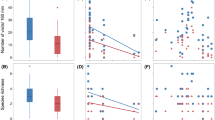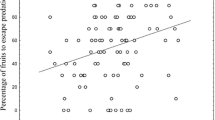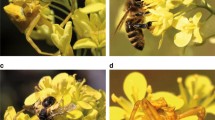Abstract
Although predators and floral herbivores can potentially decrease plant fitness by changing pollinator behaviors, studies comparing the strength of these factors as well as their additive and interactive effects on pollinator visitation and plant fitness have not been conducted. In this study, we manipulated the floral symmetry and predator presence (artificial crab spiders) on the flowers of the shrub Rubus rosifolius (Rosaceae) in a 2 × 2 factorial randomized block design. We found that asymmetry and predators decreased pollinator visitation (mainly hymenopterans), and overall these factors did not interact (additive effects). The effect of predation risk on pollinator avoidance behavior was 62 % higher than that of floral asymmetry. Furthermore, path analyses revealed that only predation risk cascaded down to plant fitness, and it significantly decreased fruit biomass by 33 % and seed number by 28 %. We also demonstrated that R. rosifolius fitness is indirectly affected by visiting and avoidance behaviors of pollinators. The strong avoidance behavioral response triggered by predation risk may be related to predator pressure upon flowers. Although floral asymmetry caused by herbivory can alter the quality of resources, it should not exert the same evolutionary pressure as that of predator–prey interactions. Our study highlights the importance of considering simultaneous forces, such as predation risk and floral asymmetry, as well as pollinator behavior when evaluating ecological processes involving mutualistic plant-pollinator systems.



Similar content being viewed by others
References
Abbott KR, Dukas R (2009) Honeybees consider flower danger in their waggle dance. Anim Behav 78:633–635
Althoff DM, Segraves KA, Pellmyr O (2005) Community context of an obligate mutualism: pollinator and florivore effects on Yucca wlamentosa. Ecology 86:905–913
Antiqueira PAP (2012) Efeitos indiretos de predadores e de herbívoros florais e foliares no comportamento de visitantes florais e sucesso reprodutivo de Rubus rosifolius. 96 f. Dissertação (mestrado), Universidade Estadual Paulista, Instituto de Biociências, Letras e Ciências Exatas. http://hdl.handle.net/11449/87627
Ashman TL, Knight TM, Steets JA, Amarasekare P et al (2004) Pollen limitation of plant reproduction: ecological and evolutionary causes and consequences. Ecology 85(9):2408–2421
Barton K (2015) MuMIn: multi-model inference. R package version 1.15.1. http://CRAN.R-project.org/package=MuMIn
Boeing WJ (2010) Defensive avoidance. In: Breed MD, Moore J (eds) Encyclopedia of animal behavior, vol 1. Academic Press, Oxford, pp 476–480
Botto-Mahan C, Ramírez PA, Ossa CG, Medel R, Ojeda-Camacho M, González AV (2011) Floral herbivory affects female reproductive success and pollinator visitation in the perennial herb Alstroemerialigtu (Alstroemeriaceae). Int J Plant Sci 172(9):1130–1136
Brechbühl R, Casas J, Bacher S (2010) Ineffective crypsis in a crab spider: a prey community perspective. Proc R Soc B 277:739–746
Burnham KP, Anderson DR (2002) Model selection and multimodel inference: a practical information-theoretic approach, 2nd ed. Springer, New York
Card GM (2012) Escape behaviors in insects. Curr Opin Neurobiol 22:180–186
Card G, Dickinson MH (2008) Visually mediated motor planning in the escape response of Drosophila. Curr Biol 18:1300–1307
Cardel YJ, Koptur S (2010) Effects of florivory on the pollination of flowers: an experimental field study with a perennial plant. Int J Plant Sci 171:283–292
CariveauD, Irwin RE, Brody AK, Garcia-Mayeya LS, Von der Ohe A (2004) Direct and indirect effects of pollinators and seed predators to selection on plant and floral traits. Oikos 104:15–26
Dewell RB, Gabbiani F (2012) Escape behavior: linking neural computation to action. Curr Biol 22(5):R152
Dukas R, Morse DH (2003) Crab spiders affect flower visitation by bees. Oikos 101:157–163
Dukas R, Morse DH (2005) Crab spiders show mixed effects on flower-visiting bees and no effect on plant fitness components. Ecoscience 12:244–247
Foelix RF (2010) Biology of spiders, 3rd edn. Oxford University Press, USA
Galen C (1999) Why do flowers vary? Bioscience 49(8):631–640
Giurfa M, Dafni A, Neal PR (1999) Floral symmetry and its role in plant-pollinator systems. Int J Plant Sci 160(6 Suppl):S41–S50
GiurfaM, Eichmann B, Menzel B (1996) Symmetry perception in an insect. Nature 382:458–461
Gonçalves-Souza T, Omena PM, Souza JC, Romero GQ (2008) Trait mediated effects on flowers: artificial spiders deceive pollinators and decrease plant fitness. Ecology 89:2407–2413
Ings TC, Chittka L (2009) Predator crypsis enhances behaviourally mediated indirect effects on plants by altering bumblebee foraging preferences. Proc R Soc Lond B 276:2031–2036
Ings TC, Montoya JM, Bascompte J, Blüthgen N, Brown L et al (2009) Ecological networks—beyond food webs. J Anim Ecol 78:253–269
Karban R, Baldwin IT (1997) Induced responses to herbivory. University of Chicago Press, USA
Karban R, Strauss SY (1993) Effects of insect herbivores on the growth and reproduction of their long-lived host plant, Erigeronglaucus. Ecology 74:39–46
Knight TM, Steets JA, Vamosi JC, Mazer SJ, Burd M et al (2005a) Pollen limitation of plant reproduction: pattern and process. Annu Rev Ecol Evol Syst 36:467–497
Knight TM, McCoy MW, Chase JM, McCoy KA, Holt RD (2005b) Trophic cascades across ecosystems. Nature 437:880–883
Krupnick GA, Weis AE, Campbell DR (1999) The consequences of floral herbivory for pollinator service to Isomerisarborea. Ecology 80:125–134
Kvalseth TO (1985) Cautionary note about R 2. Am Stat 39:279–285
Lloyd DG, Barrett SCH (2006) Floral biology: studies on floral evolution in animal-pollinatedplants. Chapman and Hall, New York
Louda SM (1983) Seed predation and seedling mortality in the recruitment of a shrub, Haplopappusvenetus (Asteraceae), along a climatic gradient. Ecology 64:511–521
Maron JL, Crone E (2006) Herbivory: effects on plant abundance, distribution and population growth. Proc R Soc Lond B Biol Sci 273:2575–2584
Marquis RJ (1984) Leaf herbivores decrease fitness of a tropical plant. Science 226:537–539
McCall AC (2008) Florivory affects pollinator visitation and female fitness in Nemophilamenziesii. Oecologia 155:729–737
McCall AC, Irwin RE (2006) Florivory: the intersection of pollination and herbivory. Ecol Lett 9:1351–1365
Møller AP (1995) Bumblebee preference for symmetrical flowers. Proc Natl Acad Sci USA 92:2288–2292
Morse DH (2007) Predator upon a flower: life history and fitness in a crab spider. Harvard University Press, Cambridge
Mothershead K, Marquis RJ (2000) Fitness impacts of herbivory through indirect effects on plant-pollinator interactions in Oenotheramacrocarpa. Ecology 81:30–40
Ohgushi T (2005) Indirect interaction webs: herbivore-induced effects through trait change in plants. Annu Rev Ecol Evol Syst 36:81–105
Ohgushi T, Craig TP, Price PW (2007) Ecological communities: plant mediation in indirect interaction webs. Cambridge University Press, Cambridge
Patiño J, Guilhaumon F, Whittaker RJ, Triantis KA, Gradstein SR, Hedenäs L, González-Mancebo JM, Vanderpoorten A (2013) Accounting for data heterogeneity in patterns of biodiversity: an application of linear mixed effect models to the oceanic island biogeography of spore-producing plants. Ecography 36:904–913
Piggott JJ, Townsend CR, Matthaei CD (2015) Reconceptualizing synergism and antagonism among multiple stressors. Ecol Evol 5:1538–1547
Pinheiro JC and Bates DM (2000) Mixed-effects models in S and S-PLUS. Springer, New York
Pinheiro J, Bates D, DebRoy S, Sarkar D, R Core Team (2015) nlme: linear and nonlinear mixed effects models. R package version 3.1–122. http://CRAN.R-project.org/package=nlme
Preisser EL, Bolnick DI, Benarda MF (2005) Scared to death? The effects of intimidation and consumption in predator–prey interactions. Ecology 86:501–509. doi:10.1890/04-0719
R Core Team (2015) R: a language and environment for statistical computing. R Foundation for Statistical Computing, Vienna. https://www.Rproject.org/
Robertson IC, Maguire DK (2005) Crab spiders deter insect visitations to slickspot peppergrass flowers. Oikos 109:577–582
Romero GQ, Koricheva J (2011) Contrasting cascade effects of carnivores on plant fitness: a meta-analysis. J Anim Ecol 80:696–704
Romero GQ, Vasconcellos-Neto J (2004) Beneficial effects of flower-dwelling predators on their host plant. Ecology 85:446–457
Romero GQ, Antiqueira PAP, Koricheva J (2011) A meta-analysis of predation risk effects on pollinator behaviour. PLoS One 6(6):e20689. doi:10.1371/journal.pone.0020689
Santoro E, Machado DL (1992) Elementos geológicos da Serra do Japi (Geological elements of Serra do Japi). In: Morelatto LPC (ed) História natural da Serra do Japi. UNICAMP, Campinas, pp 24–29
Santos AMC, Carneiro FM, Cianciaruso MV (2015) Predicting productivity in tropical reservoirs: the roles of phytoplankton taxonomic and functional diversity. Ecol Ind 48:428–435
Schiestl FP, Johnson SD (2013) Pollinator-mediated evolution of floral signals. Trends Ecol Evol 28(5)
Schmitz OJ (1998) Direct and indirect effects of predation and predation risk in old-field interaction webs. Am Nat 151:327–342
Sendoya SF, Freitas AVL, Oliveira PS (2009) Egg-laying butterflies distinguish predaceous ants by sight. Am Nat 174:34–140
Sõber V, Moora M, Teder T (2010) Florivores decrease pollinator visitation in a self-incompatible plant. Basic Appl Ecol 11:669–675
Srinivasan MV, Zhang S (2004) Visual motor computations in insects. Annu Rev Neurosci 27:679–696
Stocks R, McPeek MA, Mitchell JL (2003) Evolution of prey behaviour in response to changes in predatory regime: damselflies in fish and dragonfly lakes. Evolution 57:574–585
Strauss SY (1997) Floral characters link herbivores, pollinators, and plant fitness. Ecology 78(6):1640–1645
Strauss SY, Whittall JB (2006) Non-pollinator agents of selection on floral traits. In: Harder LD, Barret SCH (eds) Ecology and evolution of flowers. Oxford University Press, Oxford
Suttle KB (2003) Pollinators as mediators of top-down effects on plants. Ecol Lett 6:688–694
Wang MY, Ings TC, Proulx MJ, Chittka L (2013) Can bees simultaneously engage in adaptive foraging behaviour and attend to cryptic predators? Anim Behav 86–859:866
Weiss MR (2004) Vision and learning in some neglected pollinators: beetles, flies, moths, and butterflies. In: Chittka L, Thomson JD (eds) Cognitive ecology of pollination: animal behaviour and floral evolution. Cambridge University Press, Cambridge, pp 171–190
Wignall AE, Helling AM, Cheng K, Herberstein ME (2006) Flower symmetry preferences in honeybees and their crab spider predators. Ethology 112:510–518
Wise MJ, Cummins JJ (2002) Nonfruiting hermaphroditic flowers as reserve ovaries in Solanumcarolinense. Am Midl Nat J 148:236–245
Wootton JT (1994) The nature and consequences of indirect effects in ecological communities. Annu Rev Ecol Syst 25:443–466
Yokoi T, Fujisaki K (2009) Hesitation behaviour of hoverflies Sphaerophoria spp. to avoid ambush by crab spiders. Naturwissenschaften 96:195–200
Zuur AF, Ieno EN, Walker NJ, Saveliev AA, Smith GM (2009) Mixed effects models and extensions in ecology with R, 1st edn, XXII. Springer, New York
Acknowledgments
We would like to thank Yuri Campanholo Gradinete and Prof. Dr André Victor Lucci Freitas for providing identifications of Hymenoptera and Lepidoptera, respectively; Dr Jennifer Thaler and an anonymous reviewer for their comments; Adriano Mendonça for providing help during fieldwork; and Prof. Dr Fernando Rodrigues da Silva for providing help with statistical analyses. We would also like to thank the City Hall of Jundiaí and staff of the Biological Reserve of Serra do Japi, Jundiaí. P. A. P. Antiqueira received a master’s degree scholarship from the Fundação de Amparo à Pesquisa do Estado de São Paulo(FAPESP; proc. no. 2009/11874-6). G. Q. Romero received a productivity grant from the Brazilian National Council for Scientific and Technological Development (Conselho Nacional de Desenvolvimento Científico e Tecnológico). The present study was funded by FAPESP.
Author contribution statement
P. A. P. A. and G. Q. R. conceived and designed the experiments, analyzed the data, and wrote the manuscript.
Author information
Authors and Affiliations
Corresponding author
Additional information
Communicated by Carlos L. Ballare.
Electronic supplementary material
Below is the link to the electronic supplementary material.
Rights and permissions
About this article
Cite this article
Antiqueira, P.A.P., Romero, G.Q. Floral asymmetry and predation risk modify pollinator behavior, but only predation risk decreases plant fitness. Oecologia 181, 475–485 (2016). https://doi.org/10.1007/s00442-016-3564-y
Received:
Accepted:
Published:
Issue Date:
DOI: https://doi.org/10.1007/s00442-016-3564-y




